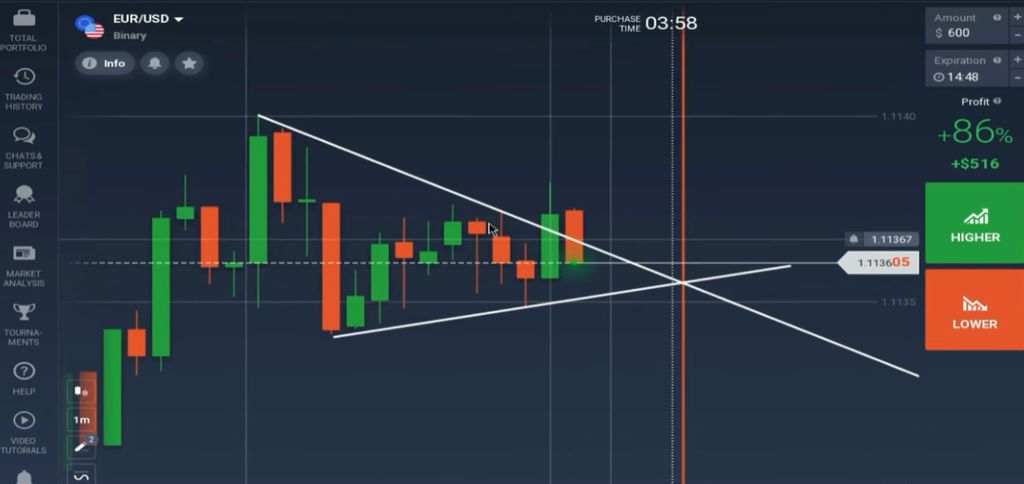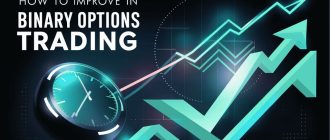Binary Options Charts: All the Essential Information You Must Know
Charts essentially show the relationship between the price of an asset and the time it takes for that price to change. By focusing on specific charting tools and indicators, traders can gain a central perspective on the market and decipher the direction in which an asset’s value is likely to move.
One of the most commonly used types of charts in binary options trading is the candlestick chart. These charts display the opening, closing, high, and low prices of an asset within a given time frame. Candlesticks are helpful in identifying bullish or bearish trends, as well as potential reversal patterns. Another popular tool is the Bollinger Bands, which show the maximum and minimum values of an asset over a specific period, helping traders determine potential entry and exit points.

Bar Charts
Bar charts are a popular type of chart used in binary options trading to provide valuable information about the price movement of assets. Unlike other types of charts, bar charts focus on the strength and direction of the trend, making them a helpful tool for traders to interpret and make quick decisions.
Understanding Bar Charts
Bar charts are essentially a visual representation of price movements over a given period of time. They consist of vertical lines, known as bars, that show the range between the highest and lowest prices within that time frame. The length of the bar signifies the price range, while a small horizontal line on the left indicates the opening price, and a small horizontal line on the right indicates the closing price.
Bar charts can be used to identify bullish or bearish trends. A bullish trend is indicated by a bar with a higher closing price than the opening price, while a bearish trend is indicated by a bar with a lower closing price than the opening price. By analyzing the pattern of bars, traders can gain insights into the overall market sentiment and make informed trading decisions.
Using Bar Charts for Trading
Bar charts are a valuable tool for traders as they provide a central and natural way to interpret price movements. They can be used in combination with other indicators, such as moving averages or Bollinger Bands, to further enhance the accuracy of trading signals. By studying the patterns and trends shown on bar charts, traders can identify potential entry and exit points, as well as determine the strength of a trend.

Japanese Candlesticks
In the world of binary options charting, Japanese candlesticks are a powerful tool that can provide valuable information to traders. These candlesticks are a visual representation of price movements over a given time frame and can be used to interpret the strength and direction of a trend. By understanding the different types of candlesticks and how to interpret them, traders can make more informed decisions and increase their chances of success.
Understanding Japanese Candlesticks
Japanese candlesticks are a natural extension of bar charts and provide a more visual representation of price movements. Each candlestick is made up of a body and two wicks, with the body representing the range between the opening and closing prices and the wicks indicating the highest and lowest prices reached during the given time frame. The color of the candlestick can also provide valuable information, with a bullish candlestick showing an upward trend and a bearish candlestick indicating a downward trend.
Types of Japanese Candlesticks
There are several types of Japanese candlesticks that traders should be familiar with. The most common ones include the doji, hammer, shooting star, and engulfing patterns. Each of these candlestick patterns has its own significance and can be used to identify potential reversals or continuations in price movements. Traders can use these patterns in conjunction with other technical tools, such as moving averages and Bollinger Bands, to further enhance their trading strategies.
Japanese candlesticks are a valuable tool for traders who wish to make informed decisions based on the strength and direction of price movements. By understanding the different types of candlestick patterns and how to interpret them, traders can increase their chances of success in the binary options market. Whether you are a beginner or an experienced trader, incorporating Japanese candlesticks into your charting tools can provide you with valuable insights and help you make more profitable trades.
Do I Have To Pay For Binary Options Charts?
Free vs. Paid Charts: What’s the Difference?
One of the first decisions traders need to make when using binary options charts is whether to choose free or paid options. Free charts are readily available online and can be a good starting point for learning and familiarizing oneself with chart analysis. These charts typically include basic features such as candlesticks, moving averages, and horizontal lines that indicate support and resistance levels.
On the other hand, paid charts often offer more advanced features and indicators that can provide additional insights into market conditions. These charts may include Japanese candlesticks, which are a popular charting technique that shows the open, high, low, and closing prices for a given time frame. They can also include indicators such as moving averages, which help identify the average value of an asset over a specific period, and wicks, which are the thin lines that extend above and below the candlesticks and indicate the bullish or bearish strength of a price movement.
The Importance of Chart Analysis
Regardless of whether traders choose free or paid charts, the main focus should be on learning how to interpret and analyze the information provided by the charts. Charts are a visual representation of market data, and they can help traders identify patterns, trends, and potential entry and exit points for their trades.
By analyzing charts, traders can determine the direction in which an asset’s price is likely to move and make informed decisions about when to enter or exit a trade. Charts can also be used to identify key support and resistance levels, which are price levels at which the asset is likely to encounter buying or selling pressure.
Choosing the Right Chart for Binary Options Trading
When it comes to choosing the right chart for binary options trading, traders should consider their trading style and the type of information they wish to focus on. Different charts offer different levels of detail and can be used to analyze various time frames.
For example, line charts provide a simplified view of an asset’s price movement by connecting the closing prices over a specific period. They are useful for getting a general overview of an asset’s price trend but may not provide enough detail for more advanced analysis.
On the other hand, candlestick charts offer more detailed information and are widely used by traders. They provide a visual representation of an asset’s price movement and can help identify patterns and trends. Candlestick charts are particularly useful for analyzing short-term price movements and can be used in combination with other indicators to make more informed trading decisions.
Types Of Binary Options Charts
One of the most commonly used types of binary options charts is the line chart. This simple yet effective charting tool represents the closing prices of an asset over a given period of time. It is essentially a horizontal line that connects the closing prices, providing a visual representation of the asset’s value over time. Line charts are useful for quickly understanding the overall trend of an asset and identifying bullish or bearish signals.
Another popular type of binary options chart is the bar chart. This charting tool provides more detailed information compared to line charts. It consists of vertical lines, or bars, that represent the price range between the highest and lowest prices of an asset within a given time frame. Bar charts are helpful in identifying volatility and assessing the strength of a trend.
Candlestick charts, also known as Japanese candlestick charts, are widely used by traders due to their ability to provide a wealth of information. These charts display the opening, closing, high, and low prices of an asset over a specific time period. Candlestick charts are particularly helpful in identifying market reversals, as they show the relationship between the opening and closing prices, as well as the range between the high and low prices.
Moving average charts are another useful tool for binary options traders. These charts display the average price of an asset over a certain period of time, smoothing out the fluctuations and providing a clearer picture of the overall trend. By plotting the moving average on a chart, traders can identify the direction of the trend and make more informed trading decisions.
Tools & Indicators
Another important indicator is the moving average. The moving average is a trend-following indicator that helps to smooth out price fluctuations and show the overall direction of the market. It is especially useful for identifying bullish or bearish trends.
In addition to candlestick charts and moving averages, there are many other indicators that can be used to analyze binary options charts. These indicators include the relative strength index (RSI), the stochastic oscillator, and the MACD (moving average convergence divergence).
Each indicator has its own unique strengths and weaknesses, and it is important to understand how to use them effectively. For example, the RSI is useful for identifying overbought or oversold conditions, while the stochastic oscillator can help determine the strength of a trend.
- Candlestick charts show open, high, low, and close prices
- Moving averages help identify trends
- Indicators like RSI, stochastic oscillator, and MACD provide additional information
- Use tools and indicators in combination with other information and experience
- Familiarize yourself with the indicators provided by your broker
How To Analyze Binary Options Charts
There are several types of charts that binary options traders can use to analyze market data. The most commonly used charts include line charts, bar charts, and candlestick charts. Each chart type has its own advantages and provides different levels of detail.
Indicators and Tools
Traders can utilize a wide range of indicators and tools to analyze binary options charts. Moving averages, Bollinger Bands, and Japanese candlesticks are just a few examples of the many tools available. These indicators can help identify trends, provide signals for entry and exit points, and show levels of support and resistance.
One helpful tool for analyzing charts is the horizontal line. By drawing a horizontal line between two points on the chart, traders can identify key levels of support or resistance. This can be useful for determining entry and exit points, as well as setting stop-loss and take-profit levels.
Interpreting Chart Patterns
Chart patterns can provide valuable information about market trends and potential trading opportunities. Bullish and bearish chart patterns, such as the double top, head and shoulders, and ascending triangle, can help traders identify potential reversals or continuations in price movements.
Another useful charting tool is the mountain chart. This chart type focuses on the maximum and minimum prices within a given time frame, providing a visual representation of price volatility. Traders can use this chart to identify periods of high volatility and potential trading opportunities.
Choosing the Right Chart
When analyzing binary options charts, it is important to choose the right chart type and time frame. Different charts and time frames can provide different levels of detail and focus. Traders should consider their trading style and goals when selecting a chart, as well as the specific asset they wish to trade.
FAQ:
What are binary options charts?
Binary options charts are graphical representations of the price movements of various assets, such as stocks, currencies, or commodities, over a specific period of time. They provide traders with visual information about the historical and current price levels, helping them analyze market trends and make informed trading decisions.
What types of binary options charts are available?
There are several types of binary options charts, including Japanese candlesticks, line charts, mountain charts, and bar charts. Each type presents price data in a different format, allowing traders to choose the one that suits their trading style and preferences.
Which binary options brokers offer the best charts?
There are several binary options brokers that offer excellent charting tools and platforms. Some of the top brokers known for their comprehensive charting features include IQ Option, Binary.com, and Nadex. Traders should consider factors such as user-friendly interface, customization options, and availability of technical indicators when choosing a broker for charts.
What are Japanese candlesticks?
Japanese candlesticks are a popular type of chart used in technical analysis. They display price information for a specific time period, showing the opening, closing, high, and low prices. The candlestick’s body represents the price range between the opening and closing prices, while the wicks or shadows indicate the highest and lowest prices reached during that period.
Do I have to pay for binary options charts?
The availability of free binary options charts depends on the broker or charting platform you choose. Some brokers offer basic charting tools for free, while others may require a subscription or a higher account tier to access more advanced charting features. It’s essential to research and compare different brokers to find the one that offers the charting capabilities you need at a price that suits your budget.
What are binary options charts?
Binary options charts are graphical representations of the price movements of underlying assets in binary options trading. They provide traders with visual information to analyze and predict market trends, helping them make informed trading decisions.
What types of binary options charts are available?
There are various types of binary options charts, including Japanese candlesticks, line charts, mountain charts, and bar charts. Each chart type presents the price data in a different format, allowing traders to choose the one that suits their trading style and preferences.





